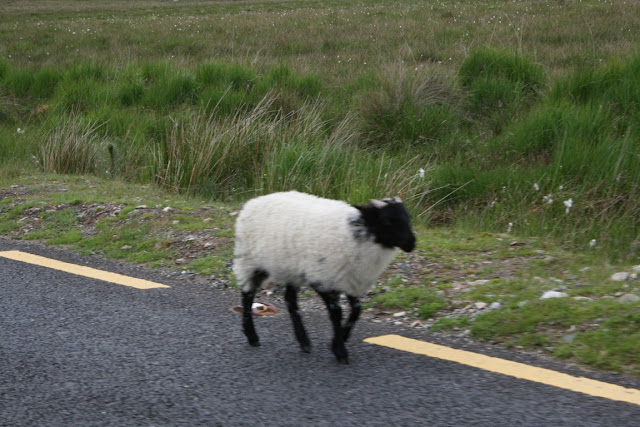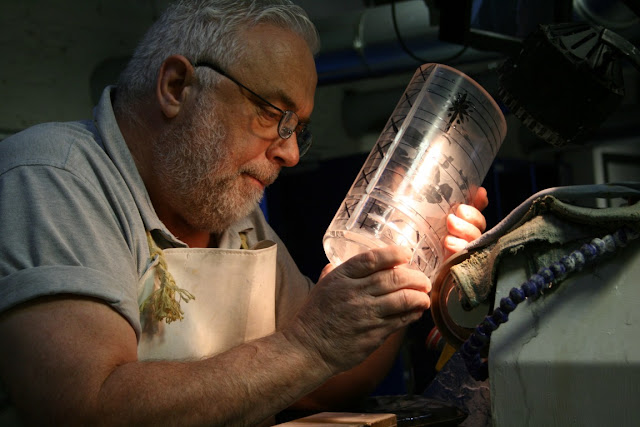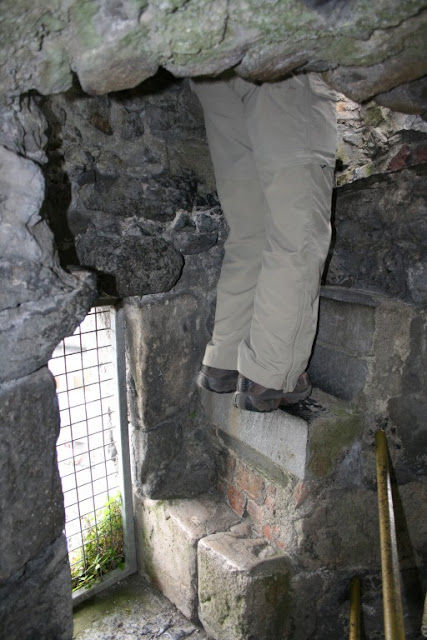The arrow points to the trim piece that would have been hard to install with the steering wheel in place. There is one like it over the glove box. They hold the bottom of the pad in place.
Wednesday, June 26, 2013
Can't Leave It Alone
My plan was to put the Mustang away for the summer, but after getting back from Ireland we have had a period of rainy weather, so I thought it would be a good time to install a new steering wheel. Having the instrument cluster in, and needing a steering wheel to steer the car over to the tool shed was the logic behind that plan. However, parts supplier and Mustang expert advised me that it would be best to install the dash pad first. There are some chrome trip pieces that fit closely around the instrument cluster and the steering wheel would just get in the way of doing that job. The dash pad cost about the same as a new steering wheel, so I have spent my parts allowance for the next couple of months. Here is how the new dash looks; I like it.
The arrow points to the trim piece that would have been hard to install with the steering wheel in place. There is one like it over the glove box. They hold the bottom of the pad in place.
The arrow points to the trim piece that would have been hard to install with the steering wheel in place. There is one like it over the glove box. They hold the bottom of the pad in place.
Tuesday, June 18, 2013
Wrapping Up
It has again been a busy few days and the internet has been a hassle. If there has been anything disappointing about Ireland, it has been the inaccessibility and slow speed of the internet. I had been led to believe that Europe was ahead of us in terms of both availability and speed, but that has not been the case. It may just be the places we have been staying. At any rate we are not here for the internet connections, so "no problem" (one of the favorite saying here). Which leads me to thinking about the Irish accent of English. We had a tour bus driver who ended most sentences with "itself", as in "There is no such thing as bad weather, only bad clothing, itself" Sort of like the Canadians put an "eh?" at the end of a sentence. Then there was the tour of the Isle Of Man by Phillip McCallen. He kept referring to "Air Pacs" as reference points for the riders on the roads. I thought he was talking about the crash cushions that are put against the walls, trees and telephone poles along the route. He would talk about "looking for the air pacs". It wasn't until the end of the tour that I realized he was talking about the "apex" of a turn.
No "th" in the language either, so eight thirty becomes "eight dirty".
At any rate, tomorrow we head for home. It has been a fabulous trip. I don't look forward to the flight back, or the amount of work it will take to catch up with things around the house, but we will get through it, and I have done the visit to the TT, a trip of a lifetime. I do look forward to getting back on my own bikes.......all of them, both motorized and not.
I will try to summarize the highlights of the past three days with some pics:
No "th" in the language either, so eight thirty becomes "eight dirty".
At any rate, tomorrow we head for home. It has been a fabulous trip. I don't look forward to the flight back, or the amount of work it will take to catch up with things around the house, but we will get through it, and I have done the visit to the TT, a trip of a lifetime. I do look forward to getting back on my own bikes.......all of them, both motorized and not.
I will try to summarize the highlights of the past three days with some pics:
Thatched roof cottages in the village of Adair
Desmond Castle outside Adair
Our very modern apartment in Galway
There has to be thousands of miles of rock walls in Ireland. This is a type of "dry stone" wall made without mortar. This one has vertically stacked rocks, but many are horizontal or even a mix.
We took an all day bus tour to the cliffs of Moher. Spectacular scenery:
A motorized two-wheeler of a different kind. There was evidently an organized tour of these things.
The Irish used to heat and cook with peat, or what they call "turf". They cut the peat out of bogs and dry it.
It becomes quite light and waterproof after it has dried. They still use it, but it is a non-renewable resource so there is some effort to preserve some of the bogs. Also, we were told that the last few years have been so rainy that it is hard to get it to dry. There still seemed many miles of bogs.
After we left Galway we headed for Kylemore Abby and walled gardens. At last Carolyn got to visit one of the gardens that were on her list of 'must see' items. There had been another one, but it was closed due to labor problems. Here is a pic from the Kylemore garden:
And here is the Abby itself:
On our way to our next two nights lodging we passed many sheep, some of them on the road itself. Most were obviously relatives of Shawn:
The roads are really narrow and curvy and usually lined on both side with rock wall. Karen is often startled when it looks like Jon is getting too close to a wall or parked vehicle on the left, but Jon says he feels he is hanging over the center line on his right. These roads often have a speed limit of 100 kph (62 mph), and it seems almost impossible to go that fast.
Monday night we arrived at Ballynahinch castle, where we are now. It is first rate:
Kicking back in the lounge
Today we took a three hour guided walk around the 300 acres of the grounds of the "castle":
And had a final fish and chips with a Guiness at a small village nearby:
Right now we are waiting for dinner after which it will be time to pack and get ready to end this "trip of a lifetime". I have nothing left on my bucket list except riding the Washington Backcountry Discovery Route, which I hope to do this summer.
Friday, June 14, 2013
Real Irish Weather
Rained all day until about 7:30 pm, but much of the day was driving from Waterford to Adair, so not much problem. We did stop in the seaside city of Ardmore where I took this pic:
Then we stopped at Blarney Castle:
While we were there Carolyn kissed the Blarney Stone, which was a bunch of malarkey. Then we got to Adair where we checked into this B&B:
And in the evening watched these guys play Irish music.
Then we stopped at Blarney Castle:
While we were there Carolyn kissed the Blarney Stone, which was a bunch of malarkey. Then we got to Adair where we checked into this B&B:
And in the evening watched these guys play Irish music.
Thursday, June 13, 2013
Waterford
We drove from Kilkenny to Waterford, which is the oldest city in Ireland. It was founded by Vikings in 914. We visited a bunch of historic places, but I suspect one of the main reasons we were there was to see the Waterford crystal factory. Jon and I thought this might be a real snoozer but it turned out to be really interesting. They started making crystal here in 1783. We got a tour of the factory and saw that the process of making a production vase starts with making a wooden mold:
Wooden molds are used for low volume production or prototypes. Actual production molds are cast iron.
Here is the motorcycle connection. The above mold was made for the Honda Classic trophy, whatever that was.
After it comes out of the mold, another worker inspects it and then disconnects it from the pipe and cools it down.
Then edges are ground and polished
After many more steps the final product looks like this:
Some of those steps consist of cutting designs into the piece. We saw men doing this on other pieces. First the layout lines are drawn:
Then cutting wheels are used to cut the glass:
Each piece in a production run is cut like this by hand. You might think it could be done by a machine, and in fact it can. They have a couple of computer aided machines that are used on very heavy pieces or for prototypes, and we saw one in action:
There is another way to make crystal, and that is by carving from a solid block. We saw a man making this Viking ship:
He sculpts individual pieces like the oars:
And the shields:
And then glues them onto the ship using an ultraviolet activated glue made by Loctite.
We saw a copy of a piece given to the New York Fire Department in honor of the priest and other first responders who died there on 9/11.
Wooden molds are used for low volume production or prototypes. Actual production molds are cast iron.
Here is the motorcycle connection. The above mold was made for the Honda Classic trophy, whatever that was.
Here is the wood shop where they make the wood molds. A woodworkers dream shop.
Next we saw them making some vases. A worker takes a rough form and forces it into a mold and then blows through the pipe to force the glass out into the mold.
After it comes out of the mold, another worker inspects it and then disconnects it from the pipe and cools it down.
Then edges are ground and polished
After many more steps the final product looks like this:
Some of those steps consist of cutting designs into the piece. We saw men doing this on other pieces. First the layout lines are drawn:
Then cutting wheels are used to cut the glass:
Each piece in a production run is cut like this by hand. You might think it could be done by a machine, and in fact it can. They have a couple of computer aided machines that are used on very heavy pieces or for prototypes, and we saw one in action:
There is another way to make crystal, and that is by carving from a solid block. We saw a man making this Viking ship:
He sculpts individual pieces like the oars:
And the shields:
And then glues them onto the ship using an ultraviolet activated glue made by Loctite.
We saw a copy of a piece given to the New York Fire Department in honor of the priest and other first responders who died there on 9/11.
Wednesday, June 12, 2013
From Castles to Churches
Today they got me inside a church......two actually.....which many will think a miracle in itself.
The first, and the big one, was Kilkenny cathedral:
Pretty grand inside:
And I was there:
Did you notice that tower outside the church?
It was built long before the church. In fact, it was built sometime in 800 to watch for, and hide from, Vikings. For a couple of extra euros you can actually climb to the top of it, so that we did. First you had to get up to the entryway:
That's the entry, that little hole about 20 ft up (the tower is 100 ft)
Then you climb a stairway that is really more like a ladder, and since the tower is tapered, it gets tighter the further up you go. The last few steps are stone and very steep:
Then you emerge at the top:
Where the view is fantastic!
This little excursion was a prime example of the difference in attitude about personal responsibility between Ireland and the US. No way would the general public been allowed to go up there in our lawyer-land. It also shows why a race like the IOM TT can be run over here.
In our wondering around Kilkenny we came upon this motorcycle shop hidden away in an alley:
The bikes were so jammed-up inside I don't see how they could get one out if you decided to buy it.
The first, and the big one, was Kilkenny cathedral:
Pretty grand inside:
And I was there:
Did you notice that tower outside the church?
It was built long before the church. In fact, it was built sometime in 800 to watch for, and hide from, Vikings. For a couple of extra euros you can actually climb to the top of it, so that we did. First you had to get up to the entryway:
That's the entry, that little hole about 20 ft up (the tower is 100 ft)
Then you climb a stairway that is really more like a ladder, and since the tower is tapered, it gets tighter the further up you go. The last few steps are stone and very steep:
Then you emerge at the top:
Where the view is fantastic!
In our wondering around Kilkenny we came upon this motorcycle shop hidden away in an alley:
The bikes were so jammed-up inside I don't see how they could get one out if you decided to buy it.
Subscribe to:
Comments (Atom)
.jpg)
.jpg)

.jpg)



















.jpg)


































